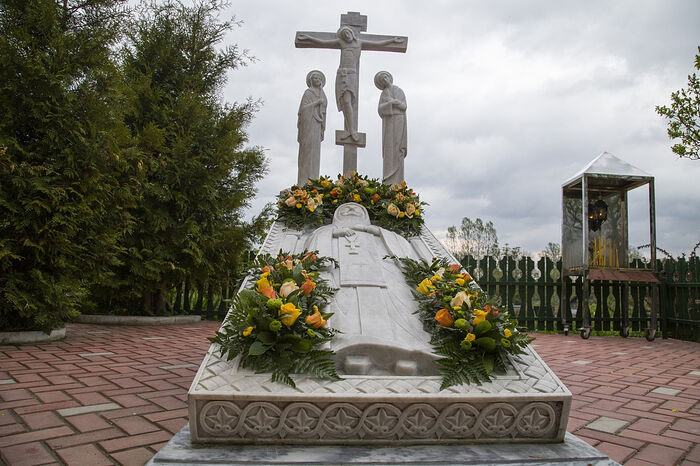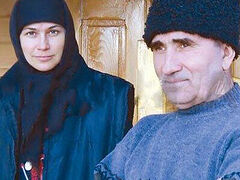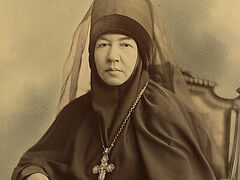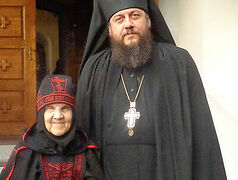Angels are a light for monks and the monastic life is a light for everyone.
St. John Climacus
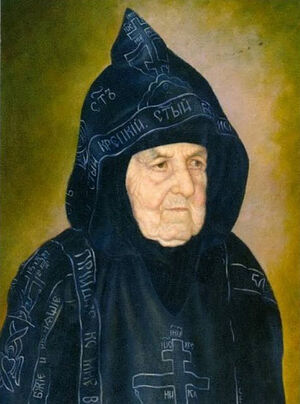 Schema-Nun Sepphora (Shnyakina) Proposals are increasingly being made to canonize the famous Eldress Sepphora (Shnyakina). More and more pilgrims are coming for help to her grave at the Monastery of the Icon of the Savior “Not Made-by-Hands” in the village of Klykovo of the Kozelsk district of the Kaluga region. More and more people share stories about their meetings with the eldress during prayer or even on the operating table.
Schema-Nun Sepphora (Shnyakina) Proposals are increasingly being made to canonize the famous Eldress Sepphora (Shnyakina). More and more pilgrims are coming for help to her grave at the Monastery of the Icon of the Savior “Not Made-by-Hands” in the village of Klykovo of the Kozelsk district of the Kaluga region. More and more people share stories about their meetings with the eldress during prayer or even on the operating table.
Matushka was born on March 19, 1896 in the village of Glukhovo of the Gavrilovka district of the Tambov province, to the large family of Nikolai and Matrona Senyakin. The girl was named Daria in Baptism. Of the Senyakins’ thirteen children only three survived: Daria and her two brothers, Vasily and Pavel. Vasily fell on the battlefield in the First World War, and Pavel was killed during the “dispossession of the kulaks” in the 1930s.
In her childhood and early youth, Daria often went to the local Church of the Protection of the Most Holy Theotokos, where some nuns lived. They taught the girl how to perform the Jesus Prayer and control her inner state. Even then Daria kept her soul pure. While young people would go around the village singing to the accordion, she did not participate in these amusements, considering them an empty pastime.
When Mother Sepphora’s father, the only breadwinner of the family, died, her mother did not have the means to send Daria to a convent, to which her soul had been longing since childhood. The girl had to consider marriage, and in 1916 the twenty-year-old Daria married her fellow villager Dmitry Shnyakin. The marriage was an act of love and obedience towards her mother, because she did not have passionate feelings for her husband. In marriage Daria gave birth to four children: a son who died in infancy, and three daughters—Alexandra, Paraskeva and Lydia. The young family lived under the same roof with her husband’s parents-. After the birth of each child, they sent her on a pilgrimage. For Daria it was a welcome gift, which she remembered with joy. Leaving her earthly chores—taking care of children, a cow and a large household—she, along with the pilgrims, went to meet the Heavenly. At that time she managed to visit Sarov, Diveevo and the holy places of Kiev.
In 1933, the Shnyakin family was dispossessed; their hut was dismantled, Daria’s parents-in-law were exiled to Solovki, and Daria and the children were thrown out onto the street. Shortly before, Dmitry had gone to work in the town of Bolokhovo eighteen miles away from Tula and started working at a mine. Daria moved in with him, and they lived there until the Great Patriotic War, when her husband went to the front, and Daria moved with the children back to the Tambov region. In 1950 her husband died, and the family took up residence in the town of Kireyevsk twenty-five miles away from Tula.
One day during prayer, Daria had a vision: angels performed the monastic tonsure over her. Arriving at the Holy Trinity-St. Sergius Lavra, she told a priest about this wonderful vision at confession. At the Lavra, on October 20, 1967, the father-superior, Abbot Gerasim, tonsured Mother Daria into the mantia with the name Dosithea. The seventy-year-old Mother Dosithea made Sergiyev Posad her home for a long time, where she lived with her eldest daughter Alexandra. At that time not only laypeople, but even monks from the monastery would come to her for advice and consolation. She knew how to comfort a grieving person, but she could also denounce someone, mentioning such sins that they did not dare utter.
After her daughter Alexandra’s death in 1984, matushka returned to live in Kireyevsk. In December 1989, Metropolitan Serapion of Tula and Belev tonsured Nun Dosithea into the schema with the name “Zipporah”, or “Sepphora” in Russian, which means “bird” in Hebrew. She so wanted to live and die at a convent, and she prayed so fervently for this to the Mother of God, that the Most Holy Theotokos appeared to her in a dream and said, “Don’t worry, you won’t die in the world. You will die in Klykovo, in a monastery.” At that time, matushka did not know where Klykovo was, and she usually asked everyone who came to her if they were from Klykovo.
The village of Klykovo is situated near the famous Optina Monastery of the Entrance of the Mother of God into the Temple. When in 1923 the churches of Optina Monastery were sealed and many priests were arrested, some of the brethren moved to the village of Klykovo. The center of the spiritual life of this community was the local Church in honor of the Icon of the Savior “Not-Made-by-Hands”. But in 1937 this church was also closed, and it was not returned to the Russian Orthodox Church until the spring of 1991. By that time the church was a sorry sight—there was no roof, no floor, no windows; even trees had grown inside. The local collective farm first used it as a repair shop, and later stored nitrogen fertilizer in it for many years.
 The Monastery of the Icon of the Savior “Not-Made-by-Hands”. Photo: Monasterium.ru
The Monastery of the Icon of the Savior “Not-Made-by-Hands”. Photo: Monasterium.ru
Archbishop Kliment of Kaluga and Borovsk blessed the setting up of a bishop’s dependency in the village of Klykovo by the efforts of the brethren who had come from Optina Monastery. The first eight monastery laborers who came here from Optina in 1993 eked out a miserable existence. Services were attended by five to eight old women. Gradually, with God’s help and private donations, by 1999 the Church of the Icon of the Savior “Not-Made-by-Hands” had been completely restored, and a monastic community had begun to form. On July 17, 2001, the Holy Synod decreed the opening of the Monastery in honor of the Icon of the Savior “Not-Made-by-Hands” in the village of Klykovo.
Mother Sepphora was very fond of Optina Monastery, in which God’s blessing always abided. In 1988 the eldress visited the famous monastery. As she walked among the ruins she said, “Grace! There is so much Grace here!” During the restoration of Optina Monastery its spiritual father, Schema-Igumen Iliy (Nozdrin), blessed the monks who were restoring Klykovo to be spiritually nurtured by Schema-Nun Sepphora. The brethren found the schema-nun and began to turn to her for spiritual guidance. They called her the “mother of monks” and a “Heavenly bird”, and the first living space built by the monk laborers was a wooden house for Mother Sepphora.
On the Nativity Eve 1996, Schema-Nun Sepphora moved from Kireyevsk to Klykovo, where she was taken by the future monastery’s father-superior—Abbot Mikhail (Semenov), who had been spiritually nurtured at Optina Monastery. From that time until her death, matushka struggled at the Monastery dedicated to the Icon of the Savior “Not-Made-by-Hands”. With the arrival of the eldress in Klykovo, life at the construction site was in full swing. From that day on the monks were no longer in such need as before; through her prayers, funds began to flow into the restoration of the church.
The eldress would come out of her cell only to church where it was terribly cold, and pieces of brick often fell from the church arches onto worshippers. The 100-year-old schema-nun stood and prayed, dressed in a light coat with a vest-jacket over it. She didn’t sit down at the Liturgy at all. She allowed herself to sit down only during Vigil when the kathismas were read; sometimes she tapped her legs with a stick, saying: “Stand! Stand!...” Matushka led a strict life of fasting. Three days before Communion she ate only prosphora and drank some water, and after taking Communion she retired and prayed without receiving anyone. In Klykovo she was visited by Optina monks, nuns and novice nuns from the Convent of St. Ambrose of Optina and the Kazan Icon of the Mother of God near the village of Shamordino; people suffering from all over Russia flocked to her for help and spiritual healing.
Schema-Nun Sepphora’s main service was eldership, which is the highest manifestation of pastoral wisdom. The Lord bestowed great spiritual gifts upon her. She comprehended many secrets of ascetic work in spirit.
“Matushka led a remarkably high spiritual life,” Abbot Mikhail recalls. “She led an angelic life. She prayed in such a way that it was obvious to me that the blind old woman saw the angelic realm as clearly as you and I see each other. The Lord endowed her with all the spiritual gifts that a human being can have.”
For her great love for God and long-suffering secret deeds, people’s thoughts were revealed to Schema-Nun Sepphora. The eldress’s spiritual legacy is her instructions—her live voice recorded on tape.
The unshakable ascetic fell asleep in the Lord on May 13, 1997 at the venerable age of 101. The funeral service over Schema-Nun Sepphora was performed by Fr. Iliy (Nozdrin). She was buried in the cemetery near the altar of St. Nicholas Chapel of the Church of the Icon of the Savior “Not-Made-by-Hands”.
After her repose miracles began to occur. There are numerous testimonies of miraculous help at her grave.
Mother Sepphora’s Instructions
When asked: “What is the main virtue?”, the eldress would answer: “To entrust all your life to God.” We cannot but recall the words of our contemporary, the philosopher Alexei Fyodorovich Losev (1893–1988): “Faith in God is theory, and trust in God is practice.”
A novice asked her:
“How should I live, Mother? Such a tough time—nothing but temptations everywhere!”
“Get out of bed and turn to the Lord: ‘Lord Jesus Christ, our God, have mercy on us.’ And ask Him for everything—where you should go and what you should do. Otherwise, the enemy will lead you. When go outside, you see seven roads, and you need only one… Be silent And keep praying: ‘Lord, my Treasure! Thou art my happiness…Thou art my Peace... I surrender to Thy will!’”
She instructed a young nun:
“Love the Psalter: it’s so sweet! The whole service is made up of it.”
Eldress Sepphora regarded the Jesus Prayer as the most important and advised people to read it everywhere: on a journey, in public places and while working; because turning to God will protect a person from evil in any life situations.
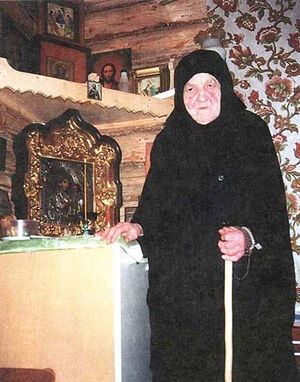 Schema-Nun Sepphora (Shnyakina) Schema-Nun Anastasia recalls:
Schema-Nun Sepphora (Shnyakina) Schema-Nun Anastasia recalls:
“She did not like it when people judged others. She forbade me to do it, saying, ‘Never dare speak ill of anyone. Everybody stands before God. The Lord alone knows how to sort out their lives. Who are we to condemn others!’”
Schema-Nun Sepphora taught her spiritual children:
“You should turn often to saints in prayer. If there are five icons in your home, you must know the troparion to and the Life of each of them, otherwise these are an exhibition of paintings rather than holy icons… We must know the Holy Scriptures, to be able to think and reflect on them.”
She kept repeating to her spiritual children:
“Pray, work and trust in God.”
She always tried to draw the attention of those who visited her to the need to control their feelings. She often said:
“Our tongue is like a dragon: we talk too much all the time. Our heart is like a lion: it is always angry and ‘growling’. Our legs are like hares: they run away from obedience and from good deeds. Our hands are like a rake: we all want to grab everything. And our eyes are like hawks: we want to see everything; curiosity gives us no rest.”
Whenever women came to her and began to complain about their lives, Mother Sepphora would warn them:
“You will be left with a trough.”
That is, if you are dissatisfied with what you have, do not appreciate it and do not thank God for it, but want to have more and more all the time, then you—like the old woman from the “Tale of the Fisherman and the Fish” by Alexander Pushkin, who was not pleased with the great gifts from the golden fish and only demanded more and more—will be left with just a broken trough. So she taught people to appreciate life and what they had.
The ascetic exhorted everyone to pray for their parents.
Mother Sepphora would say that parents should not shout at their children or scold them. They should bring up children with love and instruct them gently on the right path. A child is like raw wax, from which you can mold whatever you want. And if children are naughty or disobey their parents, the mother should pray to God that the Lord will have mercy on them and guide them on a good path. Women are often busy with themselves, and this is one of the causes of the diseases of our age.
The eldress’ prophecies
Eldress Sepphora struck people with her clairvoyance. She saw clearly the fate of every person who came to her.
The monastery’s father-superior, Schema-Abbot Mikhail (Semenov), recalls his personal communication with the eldress:
“When we didn’t have a telephone in the monastery, and it was very inconvenient; there was no contact with the outside world. When I had already arranged for a telephone cable to be laid (I had already received both a cable and a tractor), the chairman suddenly didn’t permit it! So I came to matushka in a dejected state, complaining to her about these difficulties. And she said to me: ‘Don’t worry about a phone: soon you will have a handheld one—not only will you call on it, but you will also watch TV!’ How could we have imagined this back then, if none of us had ever seen computers? They were a wonder, and at the time they were such that you could chop wood with them. But matushka already knew and understood that there would be tablets and smartphones.”
The eldress would say that Klykovo would become a town and be called Spassk, in honor of the Savior, and the spiritual heart of Spassk would be the holy monastery of the Icon of the Savior “Not-Made-by-Hands”.
Her prophecies also concerned global events in the world. “Every word of the Apocalypse must surely be fulfilled. Only unshakable faith can save humanity,” she would say. Before the Second Coming, cities will be closed and it will be impossible to go to Jerusalem.
For example, she warned that hard times (in Russia) could return: the Communists could come to power again at any moment if people stop praying and if the Church grows cool, ceasing to have high authority in society and becoming purely formal. Then denunciations against Christians will be written again and Christians will be killed again. But it won’t last: the former Government would return and sweep away the Communists. Matushka always clarified that some of her prophecies might not come true—it all depends on whether or not people sincerely turn to God with prayer.
***
To this dayб miracles occur at the grave of Eldress Sepphora. She helps everyone who comes to her with prayer requests. The Monastery of the Icon of the Savior “Not-Made-by-Hands” lovingly receives hundreds of pilgrims, monastery laborers and sufferers from everywhere. People come to Mother Sepphora’s grave and to the wonderworking Icon of the Mother of God, “Helper in Childbirth”, in front of which miracles occur as well. The monastery keeps an archive with documents and addresses of individuals who have left testimonies of healings and miracles that happened to them after praying to Mother Sepphora.

